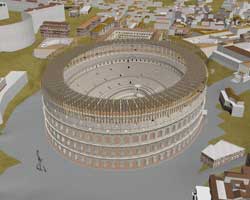 |
Touring
the Streets and Alleyways of Ancient Rome

The Roman Coliseum, as seen on Ancient Rome at Google
Earth. |
Thanks to the work of Bernard Frischer, online visitors
to Google Earth can visit Rome as it existed in 320 A.D.,
a capital of the world ruled by Constantine the Great.
Frischer, designer of
, will speak on “Making
Cultural Heritage Virtual: Rome Roeborn and Other 3D Modeling
Projects at the University of Virginia” on
Thursday, April 2, at 5 p.m. in Graham Hall, Hillyer. During
his talk, Frischer will explain how archaeologists and architectural
historians are increasingllyl finding it useful to create
digital 3D models of their objects of study. Digital models
of ancient Rome and of several historical American sties
recentlyl created at the University of Virginia will be
presented to exemplify uses of 3D models. The lecture will
be of great interest to those in a range of disciplines,
including art, computer science, history, and archaeology.
Frischer, who also serves as professor of classics and art
history, and Director of the Institute for Advanced Technology
in the Humanities at the University of Virginia, is a leading
scholar in the application of digital technologies to humanities
research and education. The works of Frischer and his institute
have received international acclaim and have been featured
on the Discovery Channel, BBC, in Newsweek and numerous
other media outlets.
His Rome Reborn project aims to give viewers a vivid look
at ancient Rome at its height in 320 A.D. The project is
the subject of a cover story in the December 2008 issue of Computer
Graphics World. As described in that story, “the
historically accurate digital re-creation—which melds
the wondrous technological achievements of the past with
those of the present—offers a comprehensive, holistic
perspective of this amazing city. The most impressive aspect
of this re-creation is the sheer scale of the model: It encompasses
7,000 carefully reconstructed, detailed period buildings…And
when this virtual model is completed in the spring of 2009,
users will be able to explore the ancient cityscape, structures,
and alleyways in real time and in high resolution. What’s
more, all the imagery and information will be rendered interactively
within the user’s Internet browser.”
Frischer’s visit
is sponsored by the programs in ancient studies and archaeology,
the departments of art, computer science, and history,
and the Lecture Committee at Smith.
|
 |























